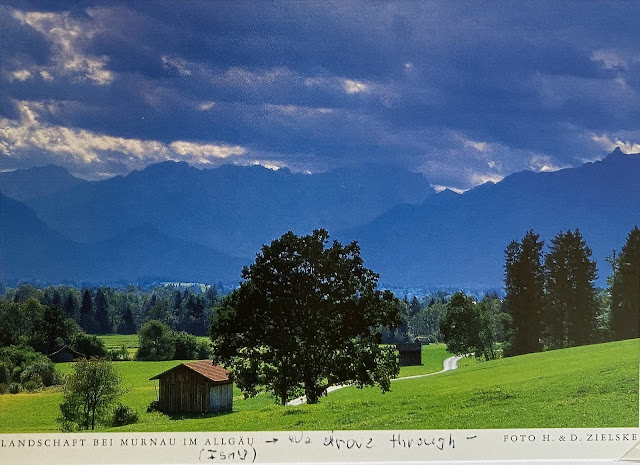December 16-17, 2000
Our next stop was Stuttgart, a city 30 miles east of Pforzheim and where my mother's friend Eberhardt was living. It is the capital of the German state of Baden-Württemberg, and with a population of over 600,000 (and over 5.5 million in its metropolitan area), it is also the largest city in the state. Porsche and Mercedes-Benz headquarters are here.
While Stuttgart was bombed 53 times by the Allies, it didn't suffer the total destruction that Pforzheim did. In total, "only" 58% of the city's buildings were destroyed, and about 4,500 people were killed.
We were there to experience our first Weihnachtsmarkt, or Christmas market. It was spectacular.
The smell of glühwein (a spicy mulled wine served hot) was overpowering, but the roasted chestnuts and chocolate made up for it!
We spent the night with the family of my mother's friend Eberhardt. They had a beautiful home in Rosenfeld, a small town of about 6,400 that lies 50 miles east of Stuttgart. They fed us an absolutely incredible dinner, one of the best we had in Germany, and treated us like visiting royalty. A year or two later they visited us on a trip through the western United States, and I'm not sure we could match their hospitality.
By the way, our youngest accidentally left his coat here. Not a good item to forget in December in Germany, but he made do with his older brother's sweatshirt for the rest of the trip.
Our next stop was Freiberg im Breisgau, a town of 75 miles southwest of Rosenberg and not to be confused with plain-old Freiberg
Anyway, Freiberg is a beautiful city, rebuilt after it too was bombed and destroyed during World War II. Today it is the "Gateway to the Black Forest." Our youngest son, now an artist, loved the colorful apartment buildings and took this picture:
Many of the photos in my scrapbook are postcards or pictures cut out of brochures. Ah, the pre-digital days! This is the Freiberg Münster, or cathedral, which took over 200 years to build and was completed in 1330. It's 380-foot-tall spire is an architectural masterpiece and a study in contradictions--simultaneously massive and delicate. In 1869, art historian Jacob Burckhardt described it as "the most beautiful spire on earth." It is the first Gothic spire ever to have open latticework, as can been seen in the second photo. This was one of the few buildings in Freiberg spared by the bombers in World War II. Even they must have been touched by its enchanting beauty.
Here are two photos I actually took myself:
There is a large cobblestone square in front of the cathedral. I love the steep roofs and tiled "hats" on the circular corner structures.
But walk through the doors into the sanctuary, and try not to gasp at the over-the-top opulence of the Rococo chapel. For whatever reason, I don't have any photos of the interior, but I remember this so well, as well as the use of the color pink, which seemed unusual at the time. I had to borrow some photos from the internet.
 |
| Photo from here |
 |
| Photo from here |
My mother pointed out the unique putto, or cherub, with his finger in the beehive.
 |
| Photo from here |
I recall my mother saying this was one of her favorite churches in Germany. It is just so UNEXPECTED!
We continued our journey east through the awe-inspiring hills and mountains of Southern Germany. There were a few times that Bob stopped the car just to get out an look at the magnificent scenery. My mother observed that she had never really known a man to be so appreciative of beauty, and I think that after 21 years of being her son-in-law, he finally won her over with his love for her country.
After we returned home, she sent me this postcard with her notation that we had driven through this area. It meant so much to her that we could appreciate the beauty of her native country.
We covered a lot of ground in two days, and my mother was an excellent tour guide.













.JPG)








(Bob) So much to love about this trip. I liked the little puffy clouds in the Black Forest that your mother called the "bunnies cooking breakfast." I loved the rococo church in Birnau that I think may have been the first rococo church I ever visited. I was blown away by the over-the-top colors and sculptures. I hated the smell of gluhwein in Stuttgart. It was so over-powering that it made me nauseous, even though I otherwise loved the Christ kindle market.
ReplyDeleteThanks for adding the detail about the misty forest--except she said "rabbits". She was never one to use the "cuter" word.
Delete